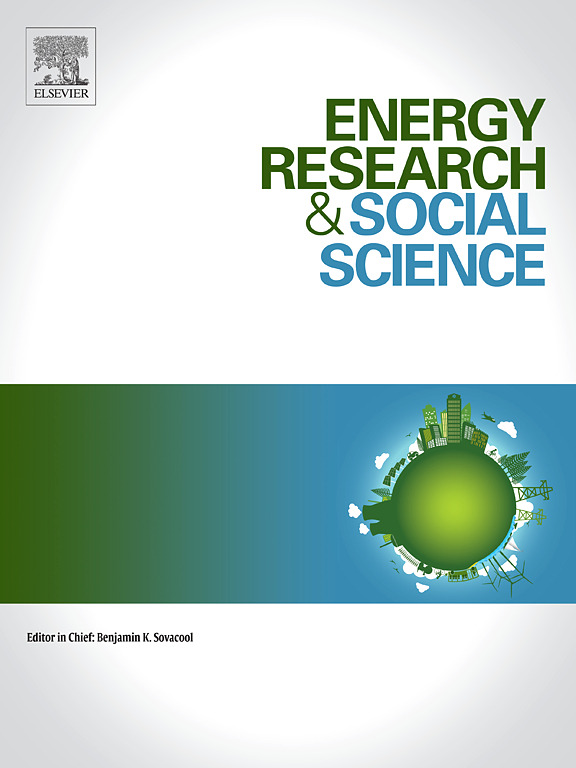观点两极:对加拿大石油大省能源发展的两极看法
IF 7.4
2区 经济学
Q1 ENVIRONMENTAL STUDIES
引用次数: 0
摘要
能源项目往往受到两极分化的意见,极端支持和极端反对都存在。这种两极分化通常没有考虑到公众对能源相关问题的偏好模型,这限制了分析师对公众接受政策或项目的动态以及如何提高接受度的理解。本研究的目的是开发一种方法来测试和解释小插曲实验中的极化,并测量水平和确定极化的驱动因素。我们的案例研究考察了加拿大阿尔伯塔省的水力压裂和风能开发。我们使用潜在类建模方法来解释两极分化或极端的受访者群体,我们将其确定为两组受访者,无论其特征如何,他们都表现出对所有能源开发的极端支持或反对。结果表明,在实验中,中立的个体对政策属性的变化反应更强烈。对政府、行业和环境组织等实体的信任有助于解释阶级成员。对小插曲实验反应中两极分化发生率的建模和偏好异质性的解释可以为开展公众参与和咨询过程的研究人员和政策制定者提供有益的见解。我们的研究结果有助于了解能源发展政策和项目的变化如何获得公众的支持,这些公众的观点对变化的特点很敏感。本文章由计算机程序翻译,如有差异,请以英文原文为准。
Opinion poles: Polarised views on energy developments in Canada's oil province
Energy projects are often subject to polarised opinions, with both extreme support and extreme opposition being present. This polarisation is often not accounted for in models of public preferences for energy-related issues, which limits analysts' understanding of the dynamics of public acceptance of policies or projects, and how acceptance could be enhanced. The objectives of this study are to develop an approach to test and account for polarisation in vignette experiments, and measure levels and identify drivers of polarisation. Our case studies examine hydraulic fracturing and wind energy developments in Alberta, Canada. We use a latent-class modelling approach to account for polarised or extreme groups of respondents, which we identify as two groups of respondents who exhibit extreme support for or opposition to all energy developments, regardless of its characteristics. We demonstrate that more neutral individuals are more reactive to changes in the policy attributes presented in the experiments. Trust in entities, such as government, industry, and environmental organisations, contributes to explaining class membership. Modelling the incidence of polarisation and accounting for preference heterogeneity in vignette experiment responses can offer beneficial insights to researchers and policy-makers that conduct public engagement and consultation processes. Our results help inform how energy development policy and program changes can be made towards garnering support from members of the public whose views are sensitive to the characteristics of the changes.
求助全文
通过发布文献求助,成功后即可免费获取论文全文。
去求助
来源期刊

Energy Research & Social Science
ENVIRONMENTAL STUDIES-
CiteScore
14.00
自引率
16.40%
发文量
441
审稿时长
55 days
期刊介绍:
Energy Research & Social Science (ERSS) is a peer-reviewed international journal that publishes original research and review articles examining the relationship between energy systems and society. ERSS covers a range of topics revolving around the intersection of energy technologies, fuels, and resources on one side and social processes and influences - including communities of energy users, people affected by energy production, social institutions, customs, traditions, behaviors, and policies - on the other. Put another way, ERSS investigates the social system surrounding energy technology and hardware. ERSS is relevant for energy practitioners, researchers interested in the social aspects of energy production or use, and policymakers.
Energy Research & Social Science (ERSS) provides an interdisciplinary forum to discuss how social and technical issues related to energy production and consumption interact. Energy production, distribution, and consumption all have both technical and human components, and the latter involves the human causes and consequences of energy-related activities and processes as well as social structures that shape how people interact with energy systems. Energy analysis, therefore, needs to look beyond the dimensions of technology and economics to include these social and human elements.
 求助内容:
求助内容: 应助结果提醒方式:
应助结果提醒方式:


